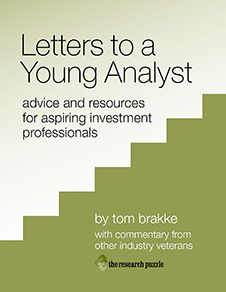
- Thursday, April 28th, 2011
- wagging the dog
-
As highlighted in the previous postingthe research puzzle | It was called, “the analysts get their turn.” analyst-run funds can deliver benefits to investment firms, by elevating the research staff internally and showcasing it externally. But there are risks as well.
One is that an analyst-run fund can cause friction between the research staff and portfolio managers. Those managers may feel like the analysts are concentrating too much on the research fund and not enough on them. To assess the likelihood of that occurring, it’s important to understand the structure of the fund and the culture of the firm. The article on the Morningstar website that rekindled my interest in analyst-run fundsMorningstar | It was authored by Karen Dolan. provided information on five such funds from well-known asset managers. (I also looked at Morningstar’s reviews and analyses on its Direct platform and reviewed fund documents.)
The funds generally maintain sector neutrality versus an index, in principle isolating the stockpicking expertise of the analysts by eliminating the sector weightings of a portfolio manager. Even within a sector, though, the methodology for selecting and weighting stocks is critical. What is it? Is there enough stock-specific alpha to be found? Is it not captured by the portfolio managers of other funds?
This gets to the heart of the issue: the roles and responsibilities of the parties and who is good at what and why. Answering the question about whether it makes sense for a firm to have a research fund requires analyzing the patterns of behavior of analysts and portfolio managers. If a research staff’s recommendations can be described as value-added, but the firm has struggled to outperform its rivals or to beat the indexes it says it can, the research alpha is being swamped by the weighting errors of the portfolio managers.While I have written extensively about the dangers of the relative performance derby, it is a fact of life and the issues related to analyst funds are best looked at in that light. Such a situation obviously presents an issue for a firm, in that an analyst fund identifies the research department’s expertise, but also highlights the fact that its traditional funds are not delivering as promised.
Conversely, if the portfolio managers of the other funds not only use research well but excel at the other parts of their jobs, what good is the research fund for the client? It gets positioned as an “index-plus” fund, which may fit the needs of those looking to minimize tracking error, but it’s rarely more than a niche product.
Other considerations:
How good is the raw material (the research recommendations)? This is a maddeningly difficult question to answer, as my previous writings on the topic have indicated.the research puzzle | Check out the “research performance” postings in this new PDF guide.
How do analysts add value within the organization?the research puzzle | See “those darn analysts” for an exposition of the functions of the typical analyst. What do you do with the recommendations of analysts that aren’t very good at picking stocks but that are essential to the organization in other ways?
How do the stocks within a sector get selected and weighted? The funds in question all appear to have portfolio managers of a sort that are key actors in that regard. (The term “high conviction” comes up a lot in coverage of these types of funds. For behavioralists, that raises the specter of the well-documented issue of overconfidence in decision making and questions about how the intra-sector weightings come to be.) I prefer a quantitative overlay that works directly off of the research output.This is, in fact, the way that the analyst fund that I was involved with was structured. A variety of different kinds of overlays are possible.
Reviewing the filings illustrates how little some firms say about their investment processes. Analyst reports from Morningstar add some helpful information, but in each of these cases I’m left with a series of questions about how they do what they do. I would want answers to the general questions above, plus the firm-specific ones, before deeming a fund worthwhile.
Ultimately, the questions narrow down to whether the fund as executed is good for the firm and good for the investor. For each, I think that the structure that is least disruptive to the core research process is preferable. In addition, it is absolutely essential that the incentives for analysts that are put in place don’t lead to the research-fund tail wagging the research-function dog, or the organization and its clients are better off without it.
